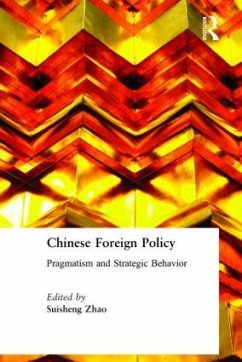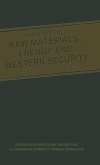- Gebundenes Buch
- Merkliste
- Auf die Merkliste
- Bewerten Bewerten
- Teilen
- Produkt teilen
- Produkterinnerung
- Produkterinnerung
This volume explores how China is adapting to international norms and practices while still giving primacy to its national interests. It examines China's strategic behaviour on the world stage, particularly in its relationships with major powers and Asian neighbours.
Andere Kunden interessierten sich auch für
![Land Tenure, Boundary Surveys, and Cadastral Systems Land Tenure, Boundary Surveys, and Cadastral Systems]() George M ColeLand Tenure, Boundary Surveys, and Cadastral Systems203,99 €
George M ColeLand Tenure, Boundary Surveys, and Cadastral Systems203,99 €![The Oxford Encyclopedia of Environmental Economics The Oxford Encyclopedia of Environmental Economics]() James R KahnThe Oxford Encyclopedia of Environmental Economics493,99 €
James R KahnThe Oxford Encyclopedia of Environmental Economics493,99 €![A Guide to the Common Diatoms at Water Pollution Surveillance System Stations A Guide to the Common Diatoms at Water Pollution Surveillance System Stations]() A Guide to the Common Diatoms at Water Pollution Surveillance System Stations35,99 €
A Guide to the Common Diatoms at Water Pollution Surveillance System Stations35,99 €![Regulating from the Inside Regulating from the Inside]() Cary CoglianeseRegulating from the Inside131,99 €
Cary CoglianeseRegulating from the Inside131,99 €![Rethinking the Oceans Rethinking the Oceans]() James Alix MichelRethinking the Oceans22,99 €
James Alix MichelRethinking the Oceans22,99 €![Raw Materials, Energy and Western Security Raw Materials, Energy and Western Security]() Hanns W MaullRaw Materials, Energy and Western Security125,99 €
Hanns W MaullRaw Materials, Energy and Western Security125,99 €![Contested Forms of Governance in Marine Protected Areas Contested Forms of Governance in Marine Protected Areas]() Natalie BownContested Forms of Governance in Marine Protected Areas194,99 €
Natalie BownContested Forms of Governance in Marine Protected Areas194,99 €-
-
-
This volume explores how China is adapting to international norms and practices while still giving primacy to its national interests. It examines China's strategic behaviour on the world stage, particularly in its relationships with major powers and Asian neighbours.
Hinweis: Dieser Artikel kann nur an eine deutsche Lieferadresse ausgeliefert werden.
Hinweis: Dieser Artikel kann nur an eine deutsche Lieferadresse ausgeliefert werden.
Produktdetails
- Produktdetails
- Verlag: Taylor & Francis Ltd (Sales)
- Seitenzahl: 334
- Erscheinungstermin: 30. November 2003
- Englisch
- Abmessung: 224mm x 172mm x 27mm
- Gewicht: 590g
- ISBN-13: 9780765612847
- ISBN-10: 0765612844
- Artikelnr.: 21487714
- Herstellerkennzeichnung
- Libri GmbH
- Europaallee 1
- 36244 Bad Hersfeld
- gpsr@libri.de
- Verlag: Taylor & Francis Ltd (Sales)
- Seitenzahl: 334
- Erscheinungstermin: 30. November 2003
- Englisch
- Abmessung: 224mm x 172mm x 27mm
- Gewicht: 590g
- ISBN-13: 9780765612847
- ISBN-10: 0765612844
- Artikelnr.: 21487714
- Herstellerkennzeichnung
- Libri GmbH
- Europaallee 1
- 36244 Bad Hersfeld
- gpsr@libri.de
Suisheng Zhao is an associate professor and Executive Director of the Center for China[1]U.S. Cooperation at the Graduate School of International Studies, University of Denver. He was the recipient of the 1999-2000 Campbell National Fellowship at the Hoover Institution of Stanford University, founder and editor of the Journal of Contemporary China, and a member of the Board of Directors at the U.S. Committee of the Council for Security Cooperation in the Asia Pacific (USCSCAP). An author and editor of four books, his most recent are Across the Taiwan Strait: Mainland China, Taiwan, and the Crisis of 1995-96 and China and Democracy: Reconsidering the Prospects for a Democratic China.
Introduction 1. Chinese Foreign Policy: Pragmatism and Strategic Behavior
Part One. Understanding Chinese Foreign Policy Behavior 2. Security
Challenge of an Ascendant China: Great Power Emergence and International
Stability 3. Four Contradictions Constraining China's Foreign Policy
Behavior 4. Chinese Nationalism and Pragmatic Foreign Policy Behavior Part
Two. Ideology, Strategic Culture, and Pragmatism 5. Pragmatic Calculations
of National Interest: China's Hong Kong Policy, 1949-1997 6. Soldiers,
Statesmen, Strategic Culture, and China's 1950 Intervention in Korea 7.
Traditional Chinese Military Thinking: A Comparative Perspective 8.
Beijing's Perception of the International System and Foreign Policy
Adjustment after the Tiananmen Incident 9. China's Pragmatic Approach to
Non-proliferation Policy in the Post-Cold War Era Part Three. Strategic
Relations with the Major Powers and Asian-Pacific Neighbors 10. Patterns
and Dynamics of China's International Strategic Behavior 11. Ghost of the
Strategic Triangle: The Sino-Russian Partnership 12. The Clash of Ideas:
Ideology and Sino-U.S. Relations 13. Making the Right Choices in
Twenty-first Century Sino-American Relations 14. The Making of China's
Periphery Policy 15. Constructing the Dragon's Scales: China's Approach to
Territorial Sovereignty and Border Relations 16. Rituals, Risks, and
Rivalries: China and ASEAN
Part One. Understanding Chinese Foreign Policy Behavior 2. Security
Challenge of an Ascendant China: Great Power Emergence and International
Stability 3. Four Contradictions Constraining China's Foreign Policy
Behavior 4. Chinese Nationalism and Pragmatic Foreign Policy Behavior Part
Two. Ideology, Strategic Culture, and Pragmatism 5. Pragmatic Calculations
of National Interest: China's Hong Kong Policy, 1949-1997 6. Soldiers,
Statesmen, Strategic Culture, and China's 1950 Intervention in Korea 7.
Traditional Chinese Military Thinking: A Comparative Perspective 8.
Beijing's Perception of the International System and Foreign Policy
Adjustment after the Tiananmen Incident 9. China's Pragmatic Approach to
Non-proliferation Policy in the Post-Cold War Era Part Three. Strategic
Relations with the Major Powers and Asian-Pacific Neighbors 10. Patterns
and Dynamics of China's International Strategic Behavior 11. Ghost of the
Strategic Triangle: The Sino-Russian Partnership 12. The Clash of Ideas:
Ideology and Sino-U.S. Relations 13. Making the Right Choices in
Twenty-first Century Sino-American Relations 14. The Making of China's
Periphery Policy 15. Constructing the Dragon's Scales: China's Approach to
Territorial Sovereignty and Border Relations 16. Rituals, Risks, and
Rivalries: China and ASEAN
Introduction 1. Chinese Foreign Policy: Pragmatism and Strategic Behavior
Part One. Understanding Chinese Foreign Policy Behavior 2. Security
Challenge of an Ascendant China: Great Power Emergence and International
Stability 3. Four Contradictions Constraining China's Foreign Policy
Behavior 4. Chinese Nationalism and Pragmatic Foreign Policy Behavior Part
Two. Ideology, Strategic Culture, and Pragmatism 5. Pragmatic Calculations
of National Interest: China's Hong Kong Policy, 1949-1997 6. Soldiers,
Statesmen, Strategic Culture, and China's 1950 Intervention in Korea 7.
Traditional Chinese Military Thinking: A Comparative Perspective 8.
Beijing's Perception of the International System and Foreign Policy
Adjustment after the Tiananmen Incident 9. China's Pragmatic Approach to
Non-proliferation Policy in the Post-Cold War Era Part Three. Strategic
Relations with the Major Powers and Asian-Pacific Neighbors 10. Patterns
and Dynamics of China's International Strategic Behavior 11. Ghost of the
Strategic Triangle: The Sino-Russian Partnership 12. The Clash of Ideas:
Ideology and Sino-U.S. Relations 13. Making the Right Choices in
Twenty-first Century Sino-American Relations 14. The Making of China's
Periphery Policy 15. Constructing the Dragon's Scales: China's Approach to
Territorial Sovereignty and Border Relations 16. Rituals, Risks, and
Rivalries: China and ASEAN
Part One. Understanding Chinese Foreign Policy Behavior 2. Security
Challenge of an Ascendant China: Great Power Emergence and International
Stability 3. Four Contradictions Constraining China's Foreign Policy
Behavior 4. Chinese Nationalism and Pragmatic Foreign Policy Behavior Part
Two. Ideology, Strategic Culture, and Pragmatism 5. Pragmatic Calculations
of National Interest: China's Hong Kong Policy, 1949-1997 6. Soldiers,
Statesmen, Strategic Culture, and China's 1950 Intervention in Korea 7.
Traditional Chinese Military Thinking: A Comparative Perspective 8.
Beijing's Perception of the International System and Foreign Policy
Adjustment after the Tiananmen Incident 9. China's Pragmatic Approach to
Non-proliferation Policy in the Post-Cold War Era Part Three. Strategic
Relations with the Major Powers and Asian-Pacific Neighbors 10. Patterns
and Dynamics of China's International Strategic Behavior 11. Ghost of the
Strategic Triangle: The Sino-Russian Partnership 12. The Clash of Ideas:
Ideology and Sino-U.S. Relations 13. Making the Right Choices in
Twenty-first Century Sino-American Relations 14. The Making of China's
Periphery Policy 15. Constructing the Dragon's Scales: China's Approach to
Territorial Sovereignty and Border Relations 16. Rituals, Risks, and
Rivalries: China and ASEAN








